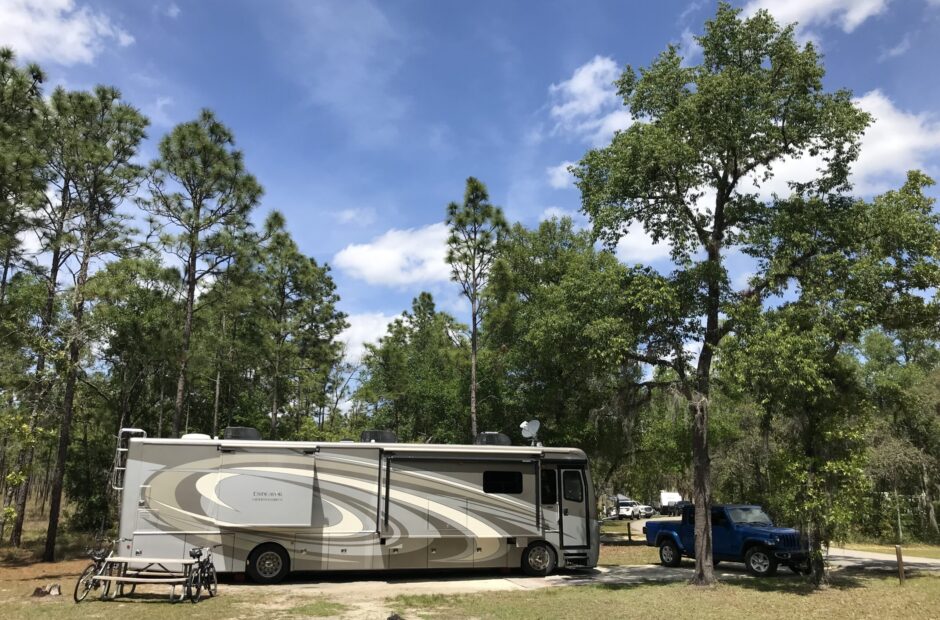Stephen Foster Folk Culture Center State Park, White Springs, Florida
Now tell the truth. What was the first thing that popped into your head when you read today’s “teaser” (as Blaine calls the post heading)? 😊
You may not know the entire song, but I’d be willing to bet that you know that part! 😊
Today, we’re going to learn a bit more about Mr. Foster and the goings on at this Park. But first, we walk a bit . . .
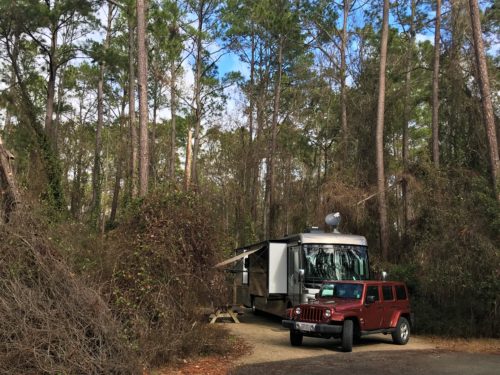
Here’s where we’re parked this time.
Heading out the door, we heard then saw, this little guy. I had to video through the screen door so as not to startle him. Made us smile!
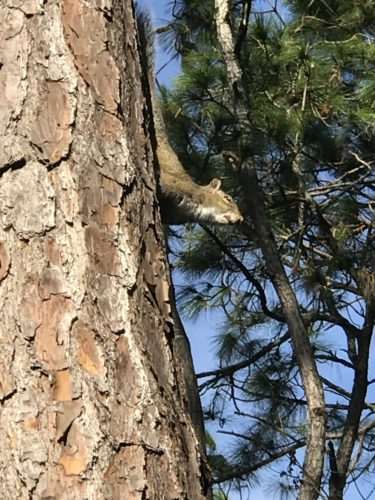
Once he took off, so did we.
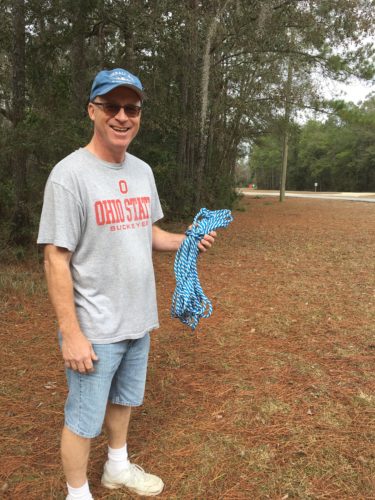
Quite possibly the greatest find since we retired.
Just look how happy he is!
He picked it up from the road and hid it. Evidently someone lost it as they were driving away.
Their loss is Blaine’s gain!
We need to find the Suwannee River that Stephen made so famous! You know, “Way down upon the Swanee River. . . ”
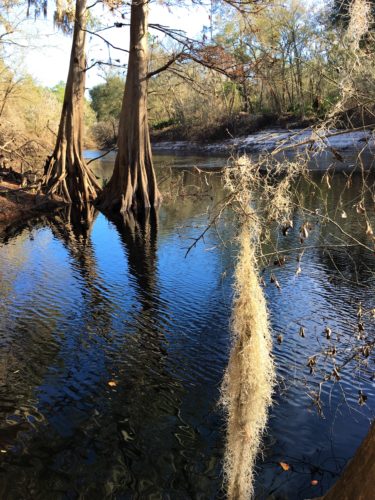
Here it is!
The Suwannee River aka Swanee Ribber.
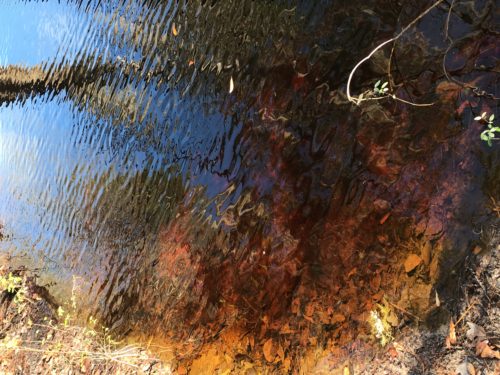
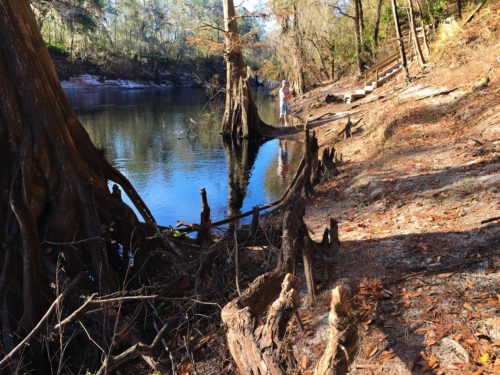
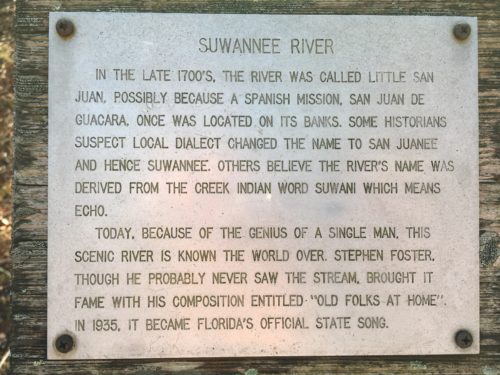
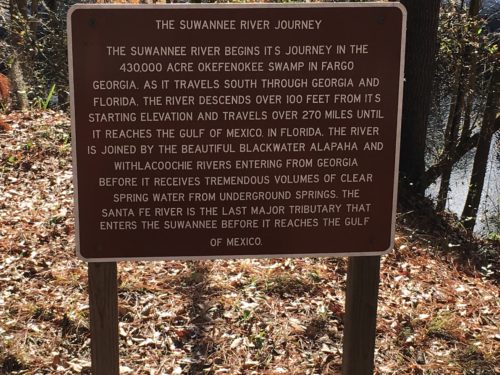
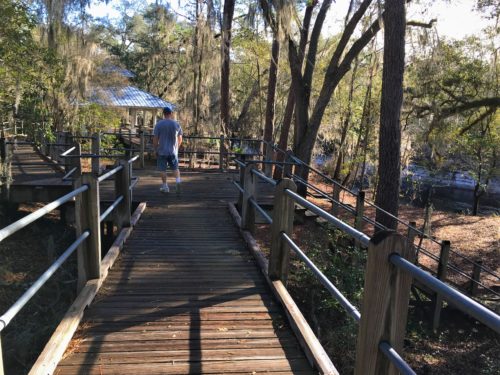
They have this really nice boardwalk to a pavilion. Apparently, they also hold weddings here.
We never would have imagined the depth changes! It’s not just the flood stages, it seems like it’s normal for the elevation to change more than 10’ at any given time!
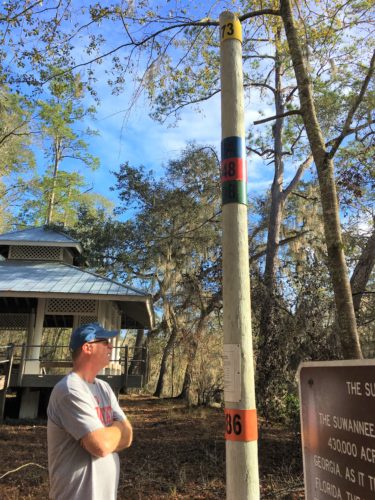
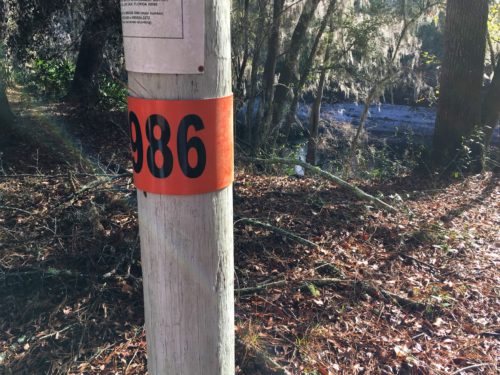
That’s the river down there in the background
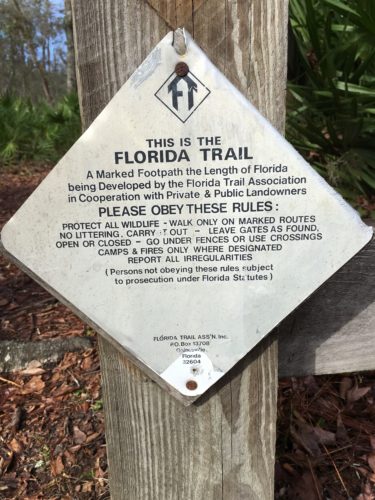
This is the trail we’re on.
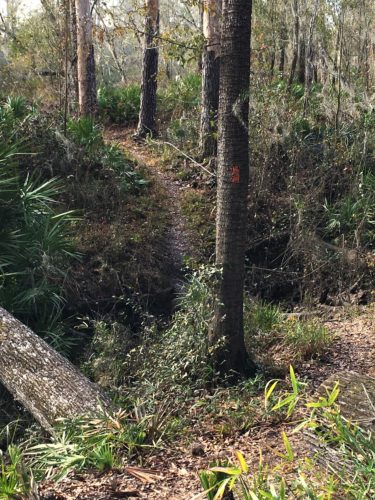
Hey! Something other than flat to walk on! : )
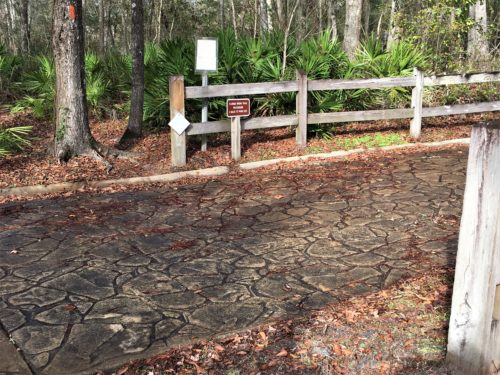
Our trail ended here for the time being.
It’s the path to the canoe launch.
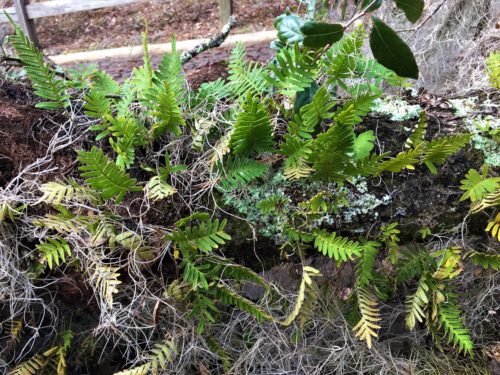
It Resurrection Ferns!
The branch fell to the ground recently, so it was easy to take a picture up close!
Pretty amazing if you ask me, especially since they say the ferns don’t harm the tree in any way.
We ran across this really cool bat house! Couldn’t see the bats, but there was plenty of evidence. Stinky! I can only imagine what a bat cave must smell like! Ewwww!!!
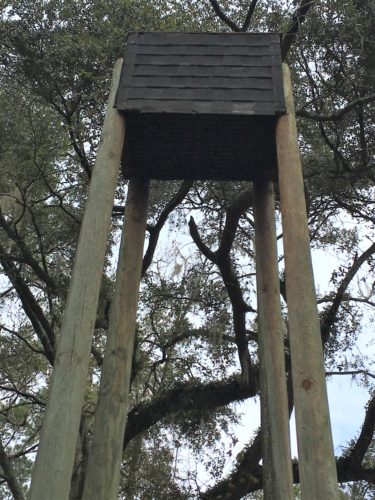
The bat house
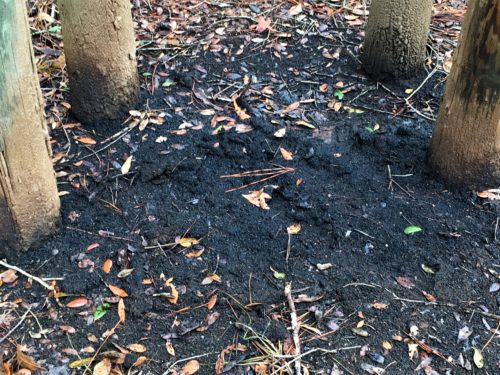
Stinky, smelly guano
We’re now back to the campground area . . . . .
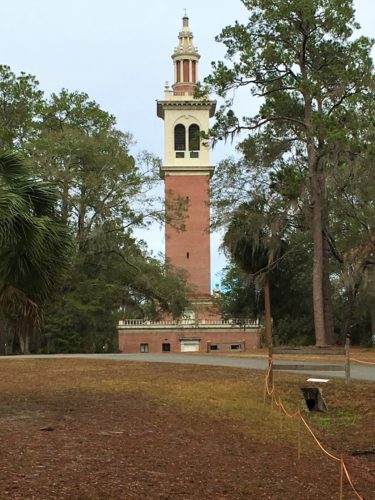
The back of the tower.
Looks like the front, doesn’t it. Haha!
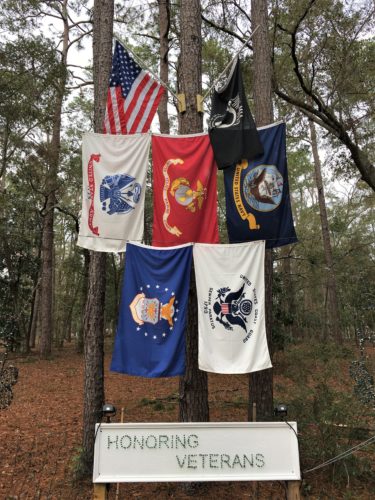
These next couple of pictures are leftover from their Christmas Light display.
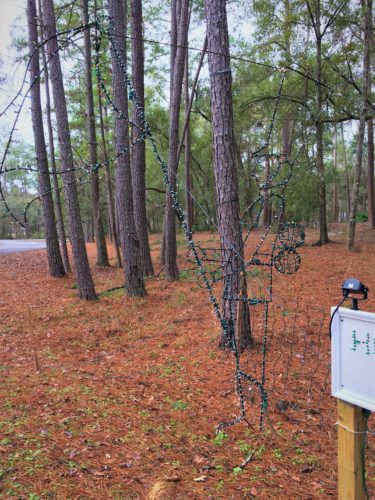
There were two of these soldiers – one on either side of the flag display.
Bet they looked great lit up!
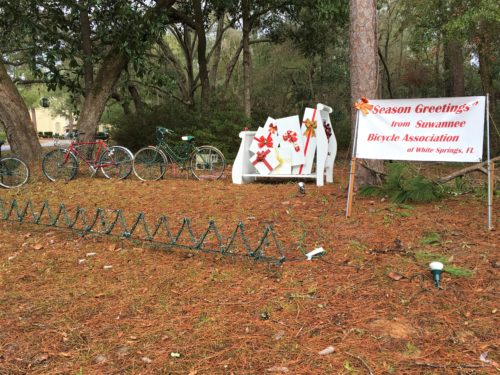
This one was pretty neat!
Bikes pulling a sleigh and a bike rack. : )
. . . . and stop back in the museum house (as opposed to the tower).
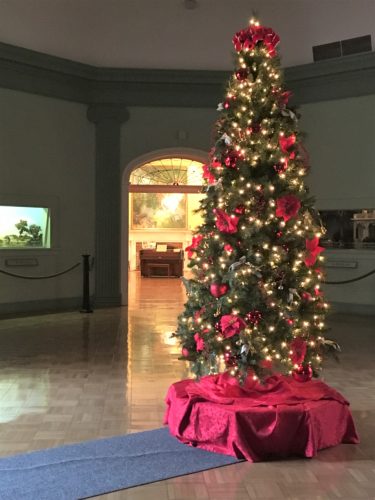
It’s still Christmas in here. : )
Now we get to learn about Mr. Foster and the history behind “Why here, when he was from Pennsylvania?” The history part is simple. It’s because he randomly chose the name of this river for his song, “Old Folks at Home”. Literally. Random. He didn’t like the sound of the “Pee Dee” or other rivers he’d chosen, so his brother brought out an atlas and eventually hit upon “Suwannee” and Stephen said, “That’s it!” And Suwannee River suddenly becomes famous, even though he’d never seen nor heard of it – and he changed the way it was spelled.
Here’s what the Park brochure says about him:
Stephen Collins Foster, the ninth of William B. and Eliza T. Foster’s ten children, was born on July 4, 1826 in a white cottage overlooking the Allegheny River in Pittsburgh. The tenth child died as an infant, leaving Stephen as the “baby” of the family, indulged by older brothers and sisters. He attended private academies in Pittsburgh and in north-central Pennsylvania.
For a brief period, Stephen worked as a bookkeeper in Cincinnati for his brother, Dunning. In 1850, 24-year old Stephen returned to Pittsburgh and married 19-year-old Jane McDowell. Their daughter Marion was born in 1851. In 1852, the couple took a month-long cruise to New Orleans with friends, the only trip Stephen ever made south of the Mason-Dixon line. In 1853, he left Jane to go to New York; she joined him in Hoboken, New Jersey sometime in 1854. They returned to Pittsburgh in 1855 after both his parents died, living first in the family home and then a series of boarding houses.
Aside from these absences and until he went alone to New York for good in 1860, Stephen spent most of his life in Pittsburgh. He worked at his songwriting, renting a piano and second-floor office in downtown Pittsburgh and keeping a thick copybook to write down ideas for song lyrics and melodies.
Foster was a pioneer. There was no music business as we know it (sound recording was not invented until 13 years after his death; radio, 66 years), no “performing rights” fees, no way of earning money except through a 5 to 10 percent royalty or through the outright purchase of songs by his publishers. In today’s music industry, he would be worth millions of dollars a year.
On January 13, 1864, weakened by a persistent fever, he died at the age of 37 with 38 cents in his pocket and a scrap of paper that read, “Dear Friends and Gentle Hearts.”
Today, more people know the myths about Stephen Foster than the facts. In truth, he was not a Southerner, he did not glorify slavery, he was not a carefree spendthrift, and he did not die an alcoholic. He was a professional, our first original songwriter, “America’s Troubadour.”
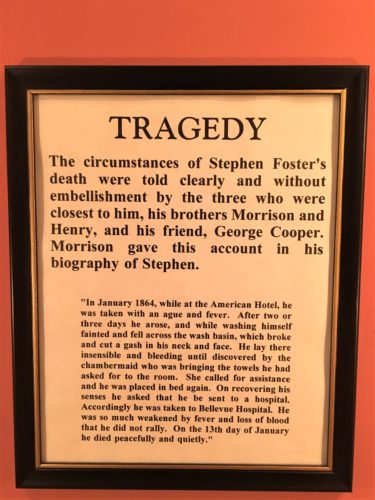
Sad ending to a brilliant man.
And a bit of trivia that lists some of the ways he’s been commemorated because of the way his music has impacted our society:
• Stephen Foster Memorial, University of Pittsburgh, Pennsylvania
• Stephen Foster State Park, near Fargo, Georgia in the Okefenokee Swamp
• Stephen Foster State Folk Culture Center, White Springs, Florida
• Five bridges recognize “Swanee River”
• Seven artists have painted his portrait
• Eight cities in the United States have schools named Steven Foster. Three are in Florida.
• There is a dahlia, a rose, and orchid and a camellia named for Foster
• There is a railroad car and a naval ship named for him
• In 1936, a 50-cent coin was minted with the Stephen Foster name
• There is a 1-cent Stephen Foster postage stamp
• A movie entitled “Swanee River” was produced, starring Don Amechi and Al Jolson
• Four of Stephen Foster’s songs may be found in the movie “Gone with the Wind”
• “Beautiful Dreamer” can be found in the first of the latest release of the “Batman” movies
• Kohler and Campbell built a piano and named the series Stephen Foster
• Foster wrote two songs in his lifetime that were later adopted as State Songs, “Old Folds at Home” (Florida) and “My Old Kentucky Home” (Kentucky)
Here’s a picture that shows all 200 of his published works. I know you probably can’t read them very well. I read them all and there are only 7 that I recognize – at least by title.
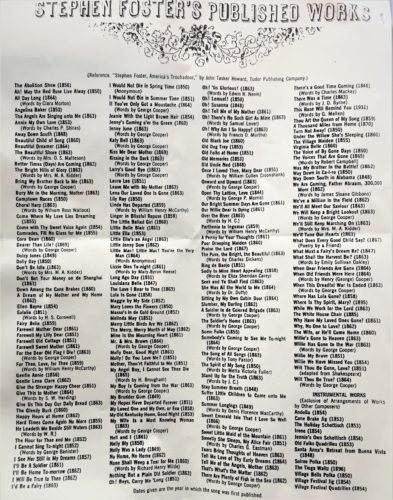
They have all these gorgeous and unusual pianos!
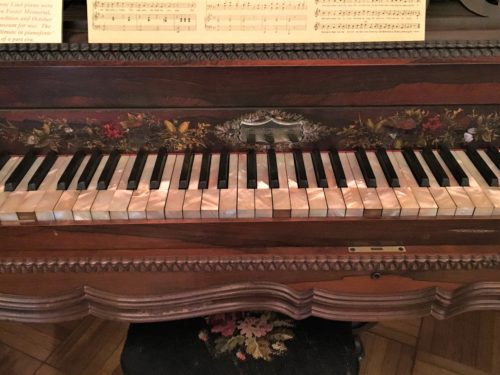
Just look at the beauty!
And the real mother of pearl keys!
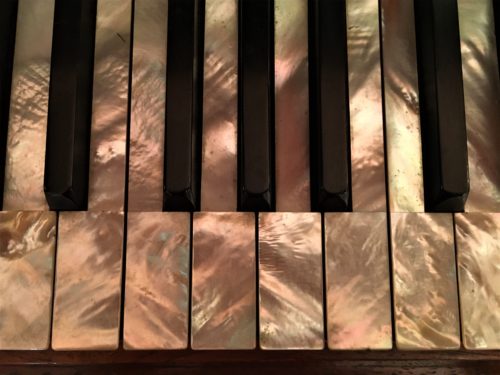
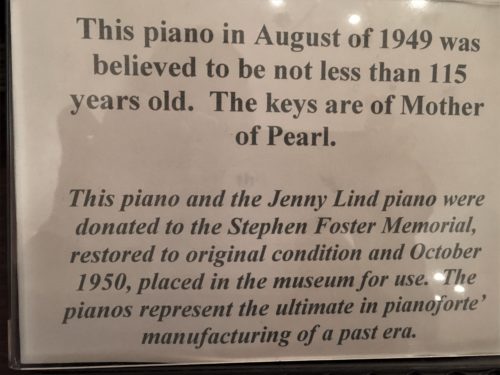
This goes with the previous two pictures
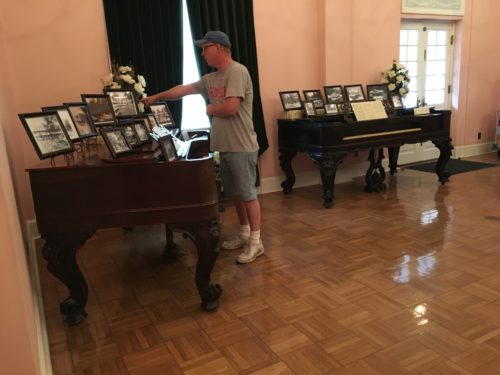
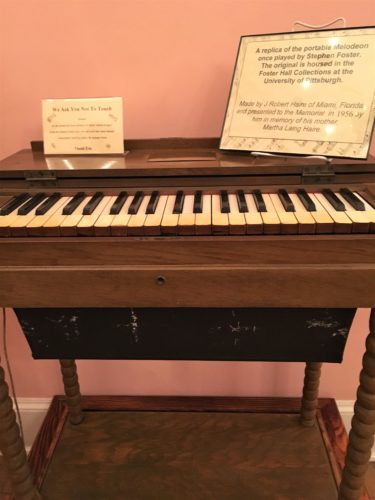
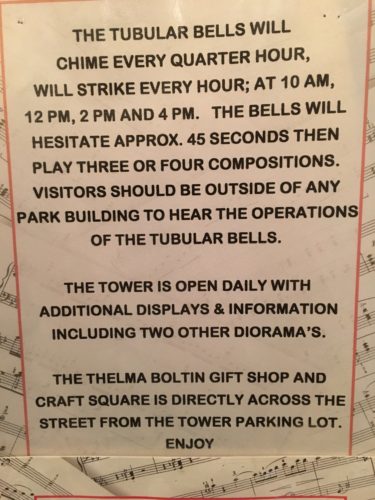
Not sure why this is in here?
But the bells haven’t worked since the tower was struck by lightening. I don’t know when that was, but a ranger in the gift shop said it would cost $300,000 to fix it.
They’re in the process of raising funds because the State of Florida doesn’t have the money.
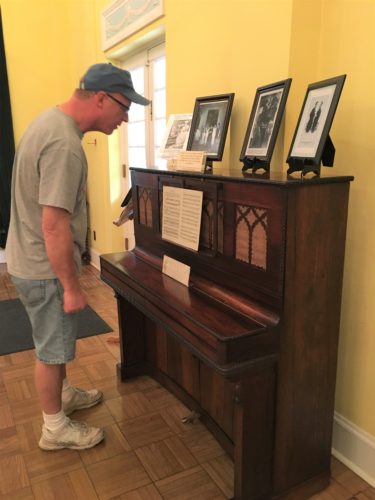
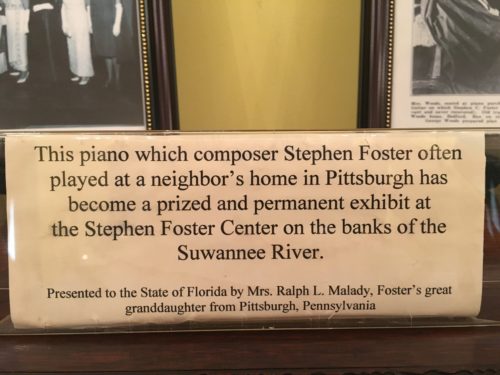
This goes with the previous piano that Blaine was looking at.
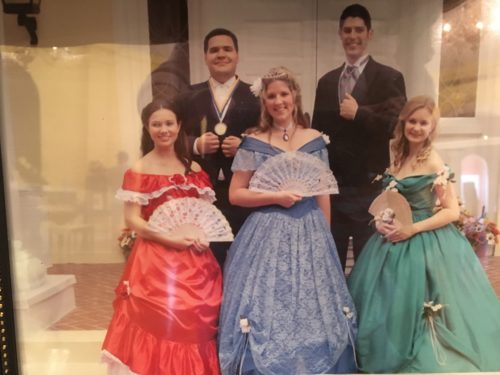
Contestants in a Stephen and Jeanie contest they hold every year since the 1950’s.

This Steinway Concert Grand was the most unusual we’ve ever seen or heard tell of!
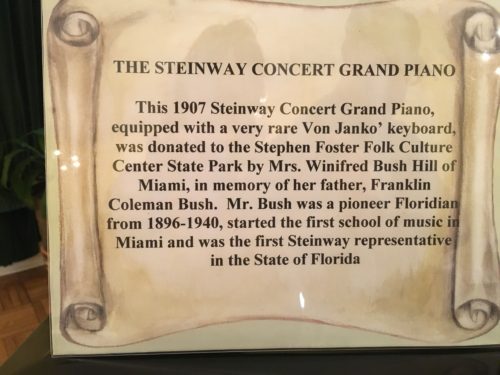
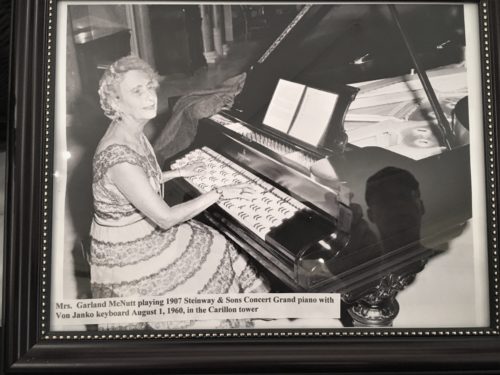
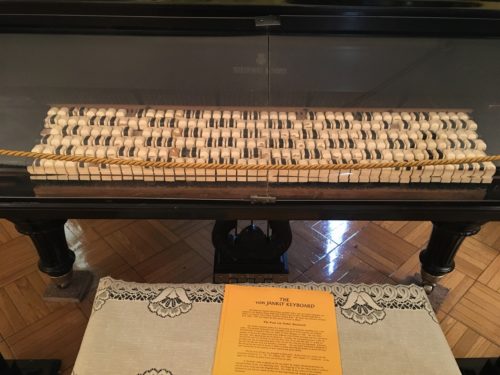
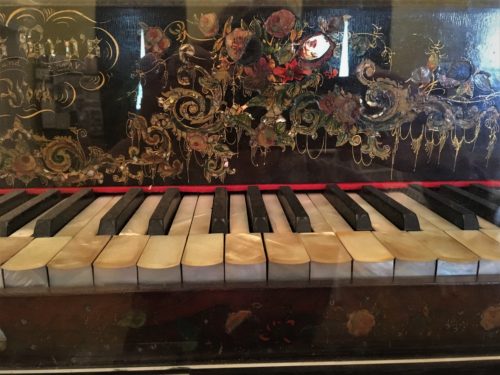
More art and mother of pearl keys!
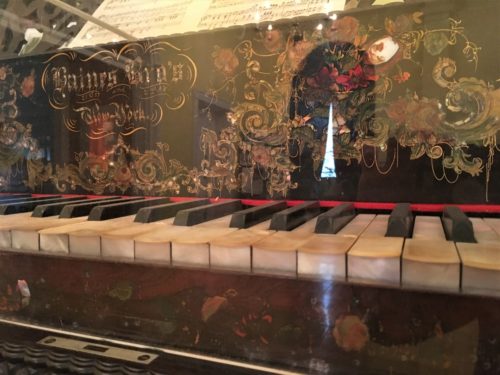
And there are these dioramas in the museum that are incredible! I’m not certain when they were created, but possibly around the time they decided to built the Park – late 1950’s? Beside being amazingly well-built works of art, they each have some type of animation. I have 8 of supposedly 10 dioramas. I have no idea where the other 2 might be. We stepped into this building twice on two different days, but never saw a soul.
Take a look! After the pictures, I’ve included some excerpts from a brochure they have about them, and fully admit to taking a few “editing” liberties.
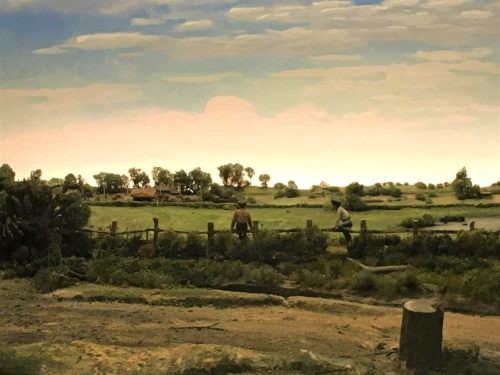
Camptown Races – 1850
If you look close, you can just make out the little horses in the background.
They run across, right to left as small horses, then come around from left to right as larger ones! (perspective remember?)
Very cool~
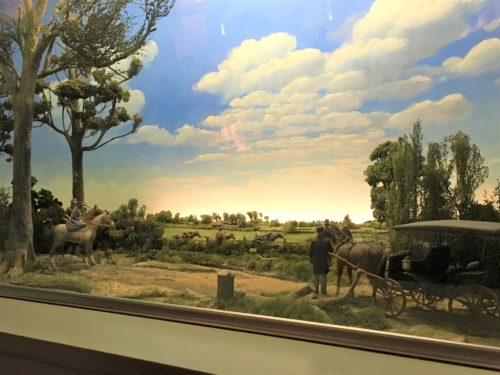
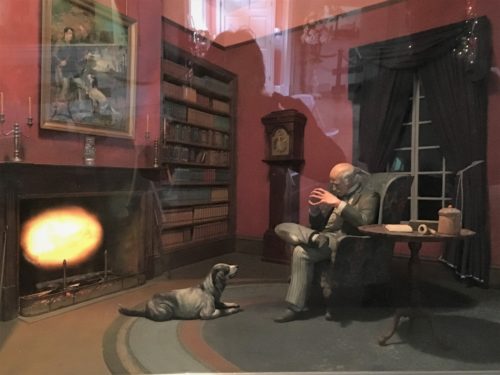
Old Dog Tray – 1853
The fireplace glows with scenes from the past.
How did they do that??
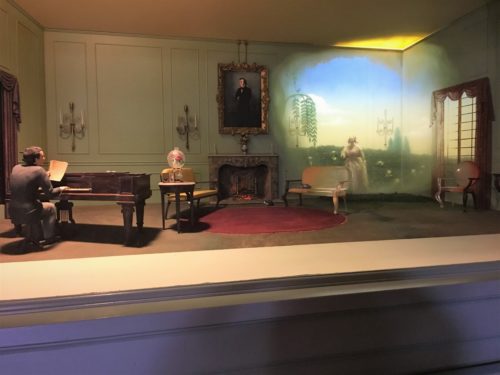
I Dream of Jeanie with the Light Brown Hair – 1854
Jeanie was actually his wife Jane.
Look how they did this dream scene!
See how the furniture, etc. fades away?
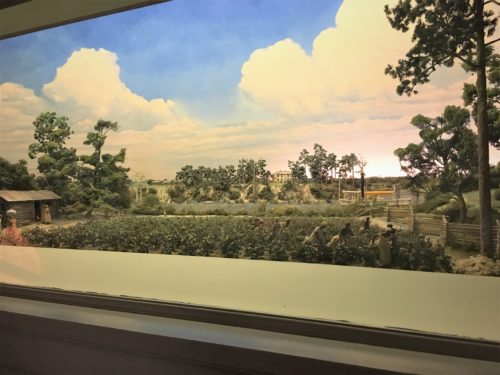
Way Down Upon the Swanee Ribber – 1851
The river boat that runs across this one.
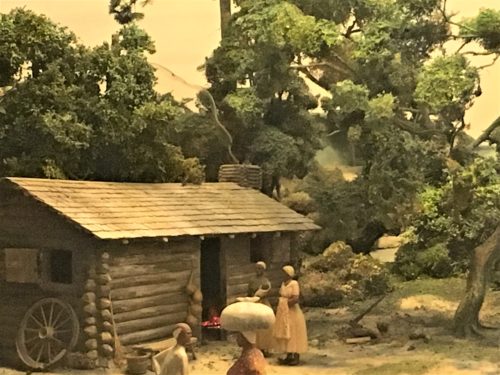
Swanee Ribber – but look at the chimney smoke.
It was actually billowing! and the fire was sparkling!

My Old Kentucky Home – 1853
The mule and cart wander slowly down the road
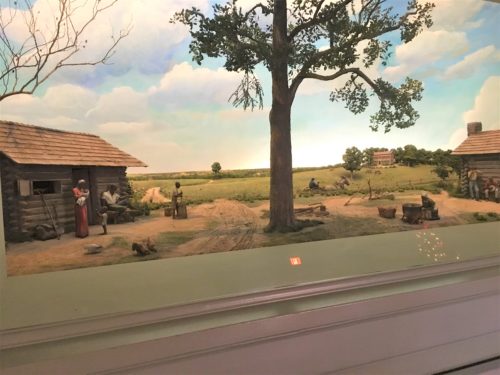
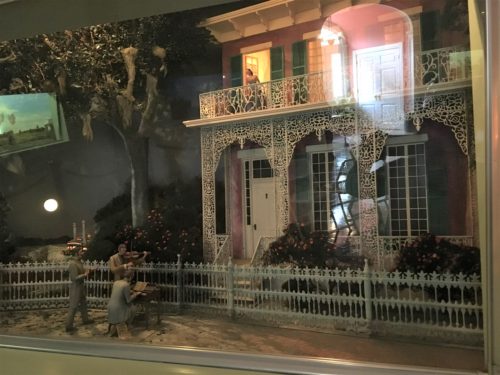
Open Thy Lattice Love – 1844
His first published composition.
The violinist is playing, and the moon is brightly lit.
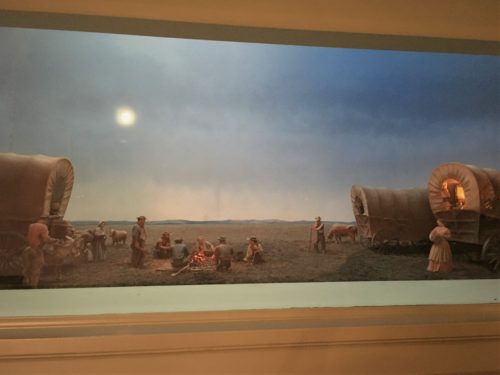
Oh! Susanna! – 1848
We never spotted any animation other than the flickering fire light, but the wagon was lit up showing shadows of the contents and the moon was bright.
Notice the rain in the background?
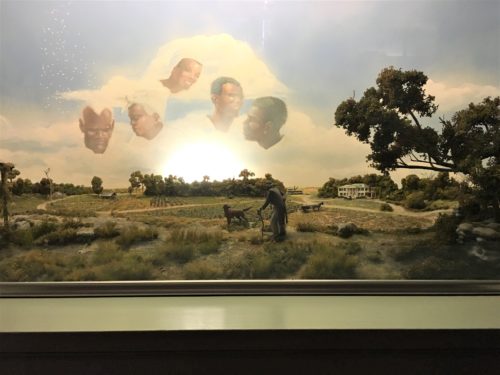
Old Black Joe – 1860
This one also has a river boat cruising along in the background.
Each of the ten dioramas illustrate the words of a song by Stephen Foster. The Stephen Foster Memorial Commission selected the songs to be depicted, basing their choice upon the popularity and human interest of the songs.
They required a great amount of planning, research and imagination. Fourteen artists spent nearly two years creating the first 8! From beginning to end, these dioramas averaged about 1,500 manhours each, or a total of about 15,000 hours (one person’s full-time for nearly 8 years!)
Nothing you see in them was purchased except as raw material. Everything was handmade especially for each setting. As an example, the first rows of cotton in “Way Down….” Were made by hand. Each paper leaf was individually fastened to metal stems, stems to twigs, twigs formed into a plant, painted and the bolls of cotton attached – – all by hand. It took considerable research to find the speed of the paddle wheel on the “Belle of the Suwannee” so that it would turn the exact speed it did in real life. Although the firearms of the ‘49ers in “Oh! Susanna!” do not attract a great deal of attention, they are historically correct and have such details as inlaid stocks. The piano in “Jeanie…” is hand carved of solid black walnut.
It is a painstaking job to make such a model, particularly when it must be built in perspective. In order to obtain the effect of distance or space in such a small amount of depth, it is necessary to foreshorten almost everything in a diorama. The distance across the track in “Camptown Races” would probably be an eighth of a mile, but in the diorama it is only about 16 inches.
Then there were these paintings. Two humongous ones! Had I known they were painted by someone famous (read on to find out who he is), I would have taken a picture of both, but the lights reflected on them made the camera wonky. I was lucky to get one. By the way, he was paid $5,000 for each of the 62 square foot paintings.
This one is called “Beautiful Dreamer” and painted on canvas in 1948 when Mr. Christy was 75 years old.
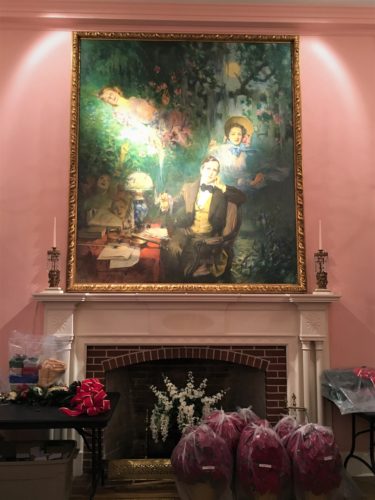
Beautiful Dreamer
The second one that I don’t have a picture of is titled, “Many Happy Days I Squandered”, from the second verse of “Old Folks at Home”. This one was painted in 1950, at 77 years old – two years before he died.
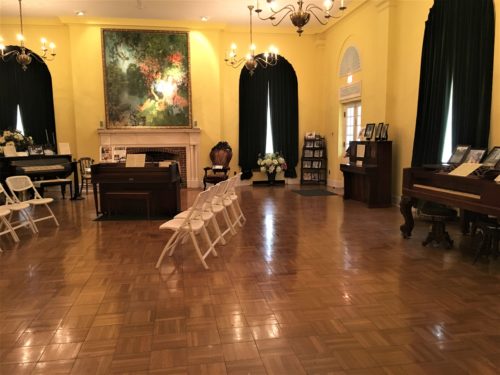
Gulp! I lied! I DO in fact, accidentally have a picture of the second painting! I just discovered it!
Here’s some information from yet another Park brochure, as well as a few pictures of some of Mr. Christy’s more recognizable works – at least to my recollection anyway.
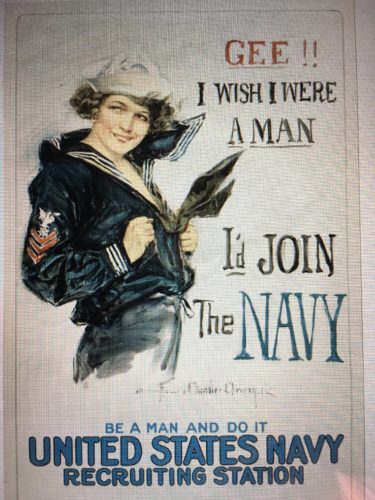

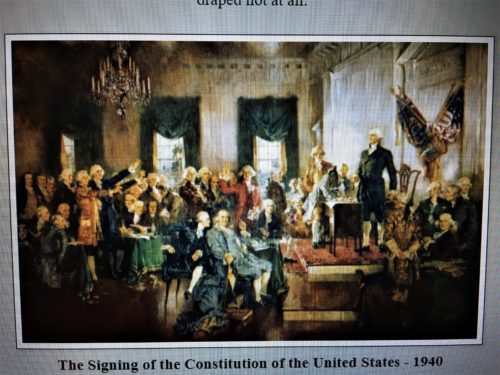
For those of you who may remember, he also painted “The Christy Girls”.
Howard Chandler Christy was born in Zanesville, Ohio on January 10, 1873. When he started to school, teachers failed to keep his attention turned to spelling and arithmetic. Looking out the window, he sketched cows and horses on his slate. He resisted the urging of teachers to hold his pencil in his right hand instead of his left, which he continued to use all his life in painting.
He was commissioned by Harper’s Weekly Magazine, Scribner’s Magazine and Leslie’s Weekly for letters and illustrations from the war zone. Franklin D. Roosevelt gave Christy credit for recruiting thousand of men by the posters he painted and donated during WWI.
His masterpiece, “The Signing of the Constitution of the United States” hangs over the grand staircase in the Capitol of the United States in Washington, DC. The painting measures twenty feet by thirty feet in size, the largest canvas in the United States.
He died on March 3, 1952. I looked. I couldn’t find anywhere that said how he died, just that it was in his studio.
We kept seeing pictures and things mentioning “Thelma Boltin” or “Cousin Thelma Boltin” around this Park, with no inkling as to who she was.
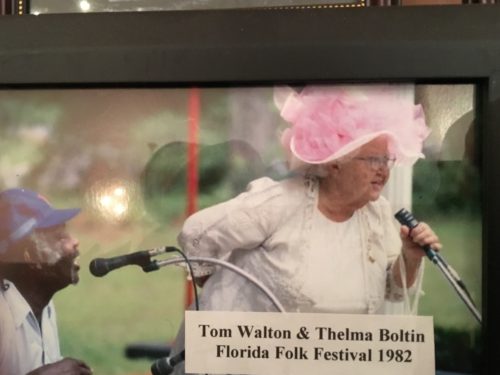
This is Thelma.
Who IS this lady??
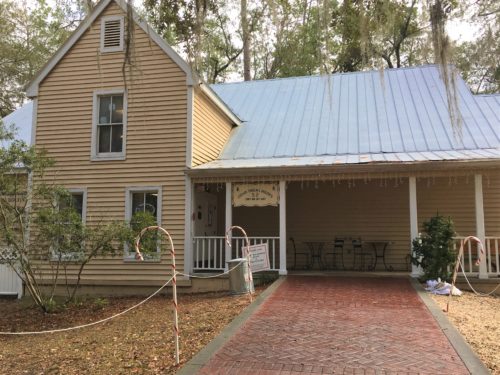
Here’s a gift shop named for her in the Park
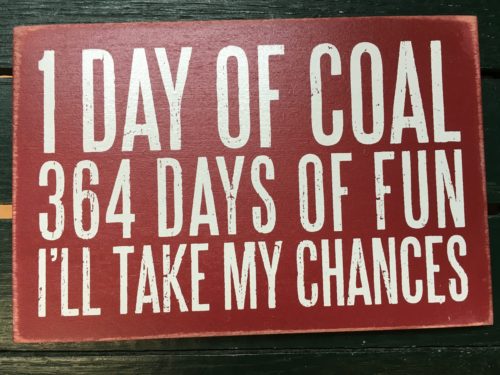
This reminded me sooo much of my youngest, I just had to take a picture and send it to him! : )

Isn’t this beautiful?
But at $50, I think maybe you could make your own. : )
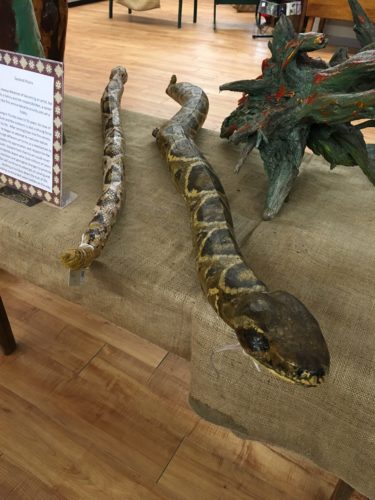
Whadayathink?
It can be yours for only $500!
Here’s what I found out about Thelma on myflorida.com’s site:
Born in Beaufort, South Carolina, Thelma Boltin moved with her family to Gainesville in 1907. She received a B.A. from Emerson College in Boston, where she studied English, drama and speech, with a particular interest in folklore. Boltin returned to teach drama at Gainesville High School, and also became active as an actress and storyteller in theater and recreation programs for Alachua County. Her background won her the position of Program Director for the Stephen Foster Center in White Springs, for which she directed the Florida Folk Festival from 1954 to 1965. At the festival, she was a fixture in her sun bonnet and pioneer dress, often telling stories of early Florida life.
Boltin traveled throughout the state searching for talent and presenting folk traditions through her program called “Florida Lore in Song and Story” to hundreds of school children and civic organizations. She also helped found the Heart of Florida Folk Festival in Dade City. Over the years she became affectionately known as Cousin Thelma to the thousands of people who attended the Florida Folk Festival from 1955 to 1986.
And then we walked some more.
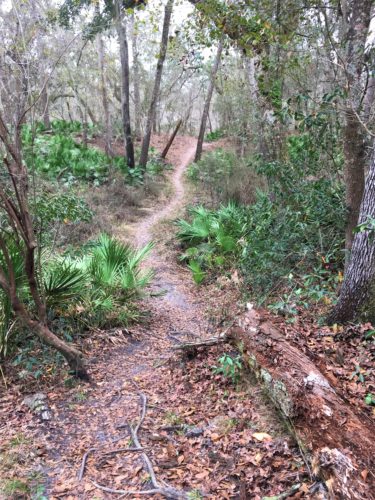
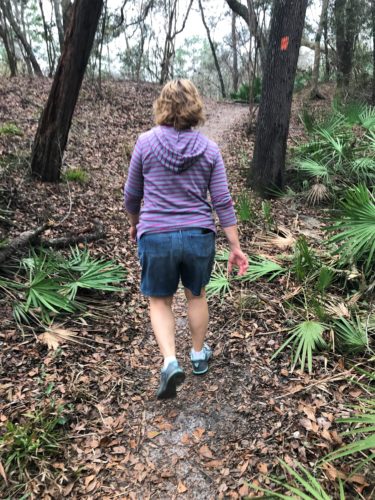
I told Blaine he needed to take a picture of me today so my Mom can see I’m wearing the top she bought me.
This is the view he chose . . . . (Sigh . . .)
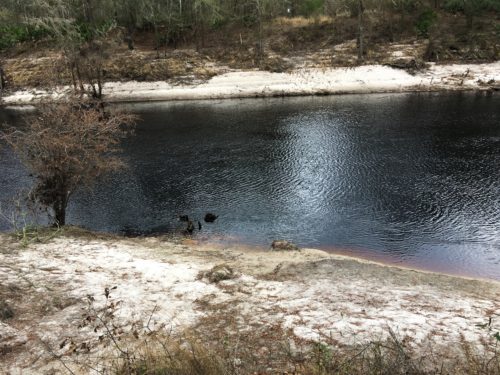
There’s the Suwannee again!
This part of the Florida Trail goes along the river.
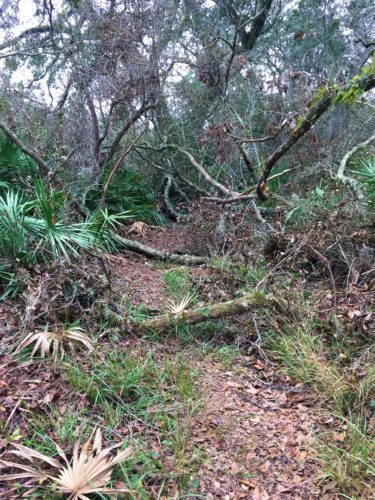
Ummm . . . .
Can you say, ‘Trail Maintenance’?
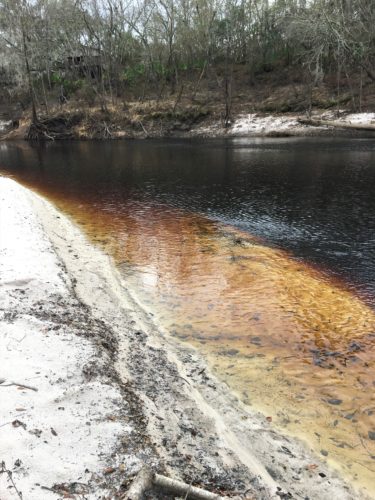
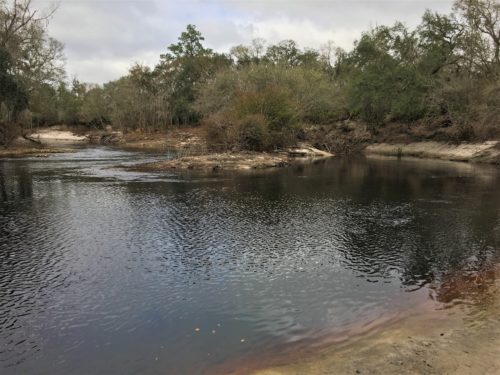
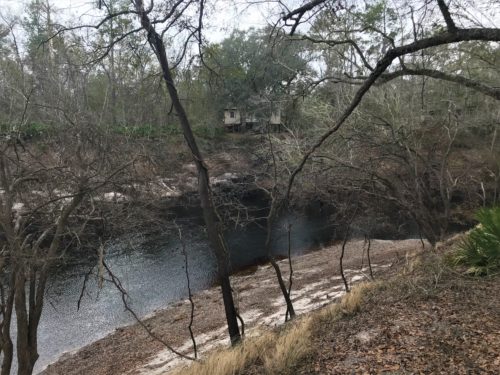
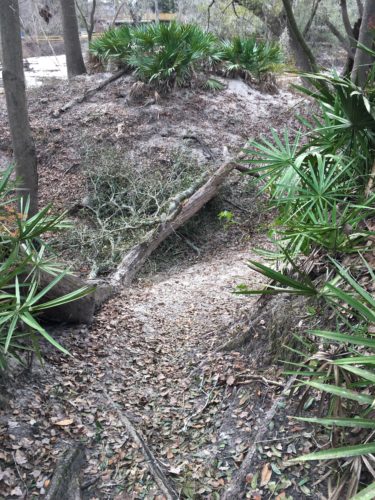
Ooooh, look! A hill!
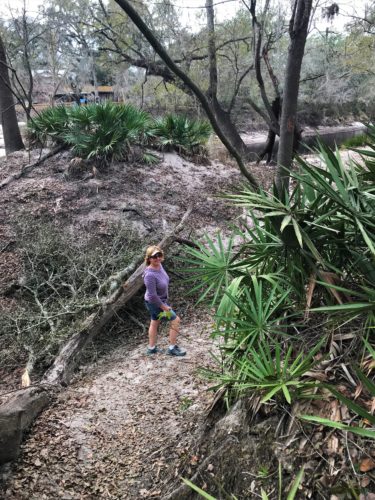
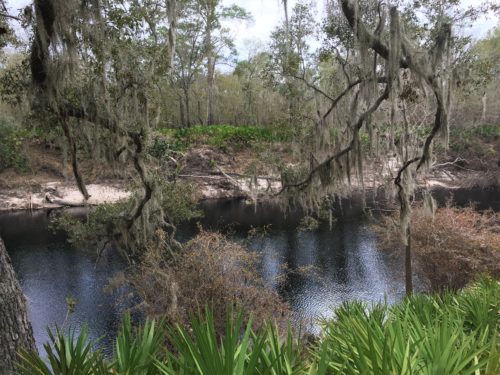
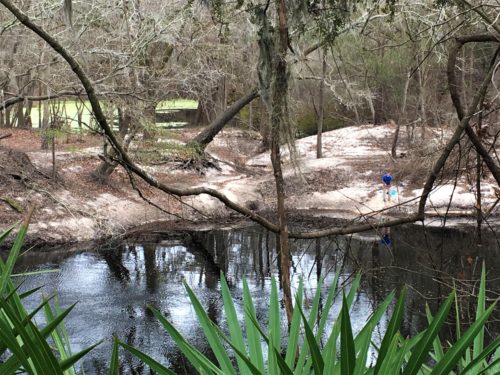
Hey! Another person!
Fishing must be good here, he’s using 3 poles.

Would you want to climb those to get to and from?
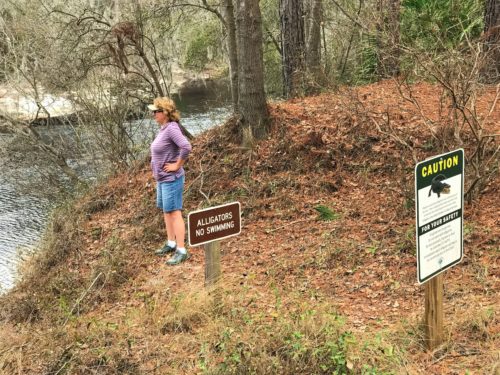
Lookin’ for the elusive gators.
Personally, I think they just put the signs up to keep people out of the river.
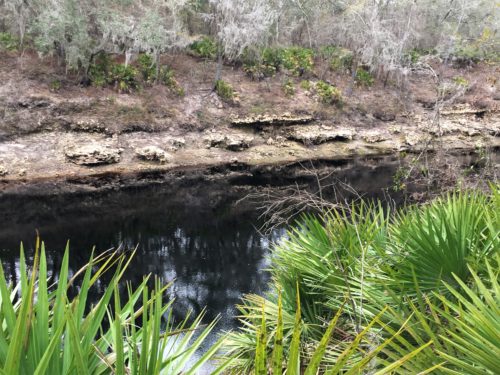
What happened to the sand?
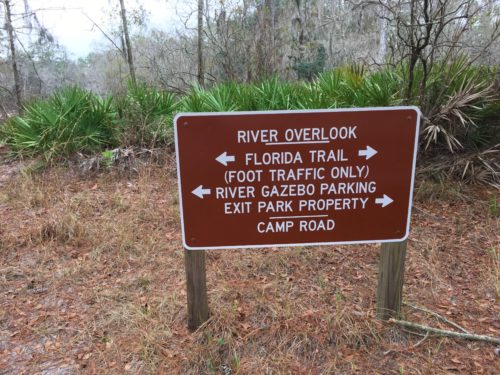
This is where we stop.
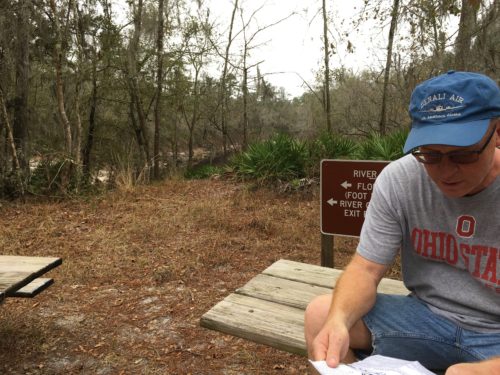
Blaine’s checking out the map trying to find us another route so we don’t have to go back the way we came.
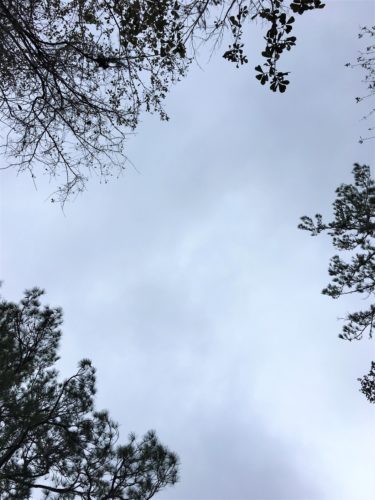
This is what I was doing.
Laying on the table watching the clouds. : )
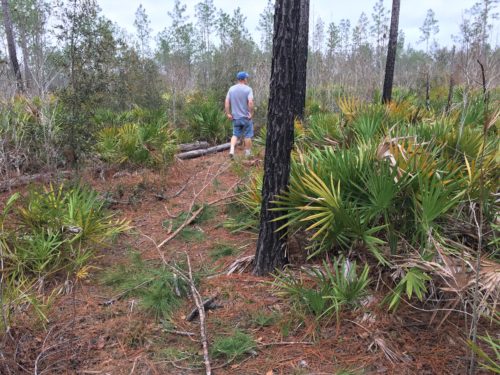
“Do you trust me?” he says.

“Sure. But all the trails are closed for a reason.”
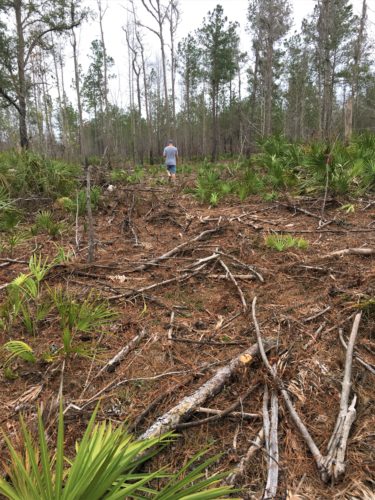
Trying to find a way home.
“It’s an adventure!”
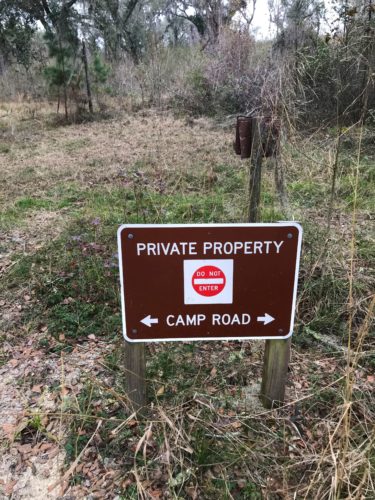
Hopefully the private part is on the other side of the sign . . . .
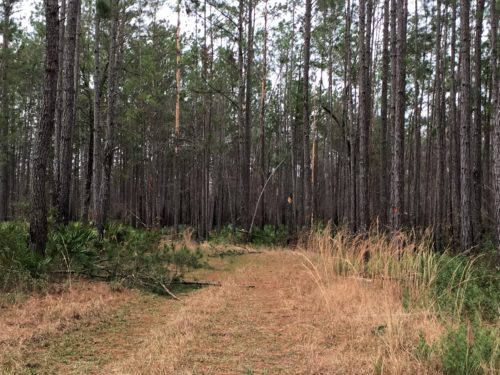
Into the woods . . .
They’ve been selective logging. All the trails are gone.
Our son called (at least we have cell service!)
We don’t know where we are. At least I don’t!
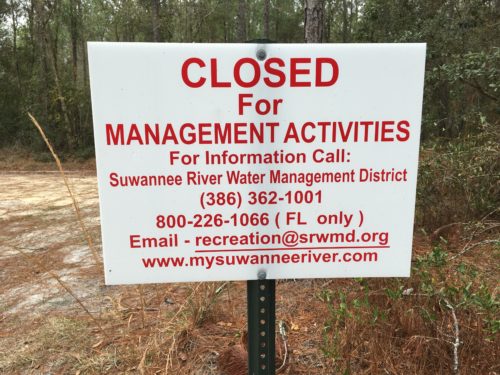
Then, just a couple of minutes later, We’re Saved!
The campground is right there!
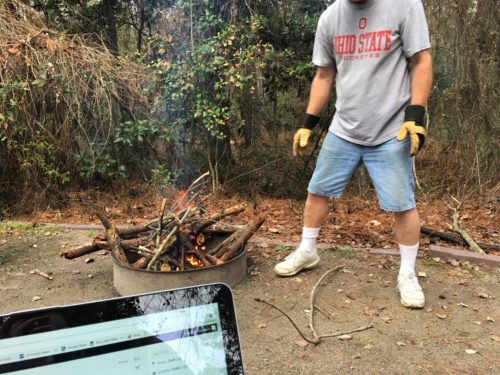
Fire tonight!
Perfect weather!
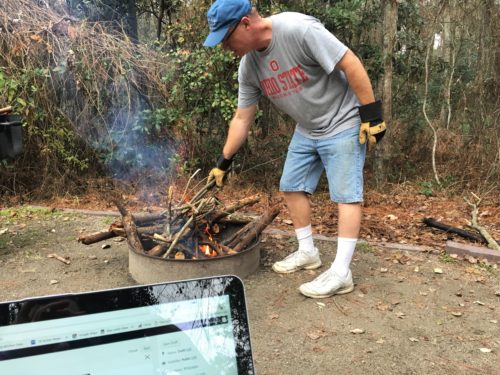
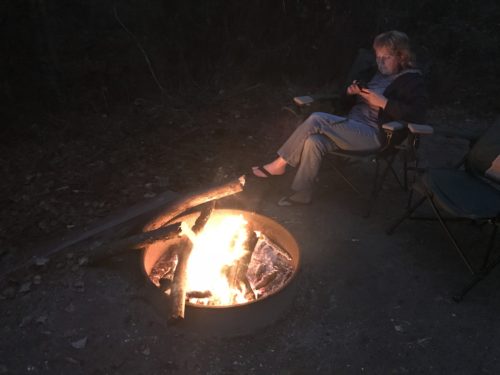
Seven-and-a-half miles today! Yippee!!
TOTAL MILES: 7.5
Year to Date: 27.75
Daily Average: 2.75
